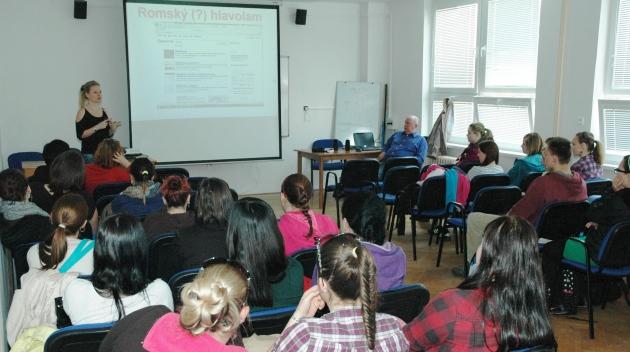Teenagers in Czech survey say Roma, "whites" both to blame for tensions

Both the majority population and the Romani minority are responsible for current tensions in the Czech Republic. That response was given by 66.1 % of the teenagers participating in a recent survey, part of a project called "Together against Prejudice" in the Frýdlantský foothills area that involved a series of discussions called "The Romani (?) Puzzle".
Not quite one-third of those surveyed ascribed the basic blame for rising tensions to Romani people only (30.6 %, to be precise), while only 3.4 % of the teenagers blamed members of the majority population only. The project is being realized by the Osvětová beseda (Educational Discussion) organization.
As part of the project, a total of 10 discussions were held at primary and secondary schools in the Frýdlantský foothills area with almost 400 young people aged between 12 and 19. There were 327 respondents to the survey, 176 girls and 151 boys.
A total of 20 respondents were Romani, while the rest belonged to the "white" majority. The survey was realized between April and June at the Economics and Forestry High School in Frýdlant and at primary schools in the towns of Frýdlant, Hejnice, Nové Město pod Smrkem and Raspenava.
The project was supported by a grant from Open Society Fund Prague. The vast majority of girls responding chose the option that the tensions are the fault of both parties (76.3 %), with 19.2 % of girls blaming Roma only and 4.5 % of girls blaming "whites" only.
Of the boys surveyed, 54 % said the blame rests with both parties, 44 % blame the Romani minority only, and only 2 % said "whites" were solely to blame. When asked whether they had personally had a negative experience with a member of the Romani minority (and, in the case of the Romani teenagers, whether they had ever had a negative experience with the "white" majority), 49.2 % of the teenagers said they had, while 50.8 % said they had not.
Boys reported a negative experience a bit more often (52 %), while 46.9 % of girls reported a negative personal experience. Almost half of the respondents (49.2 %) said their own relationship toward members of the other ethnicity was "neutral".
Those who reported a negative perception of the other ethnicity comprised 32.5 %, while those reporting a positive attitude toward the other ethnicity comprised 18.3 % of respondents. Girls are significantly more positive in this direction compared to boys – 24.2 % of girls reported a positive relationship with the other ethnicity compared to just 11 % of boys.
According to two-thirds (66.1 %) of those surveyed, most Romani people do not want to work (67.1 % of boys believe this compared to 65.2 % of girls), and 79.8 % of the teenagers believe members of the Romani minority abuse welfare (81.4 % of boys believe this compared to 78.6 % of the girls). A total of 62.1 % of the young people are convinced that Romani people receive more welfare than "whites" do (59.6 % of boys compared to 64.2 % of girls).
A total of 88.1 % of the respondents (87 % of the boys and 89 % of the girls) consider the current social welfare system in the Czech Republic to be unfair. It is precisely this allegedly unjust social welfare system that those surveyed view as the basic cause of the current tensions in society.
Of five possible causes for the current tensions, 63.6 % chose "unfair social welfare system", 61.5 % chose "inadaptability of Romani people", 50.2 % chose "high unemployment in the regions with rising tensions", 42.2 % chose "negative image of the Romani minority in the media", and 38.2 % chose "racism among the Czechs". Boys most often chose "inadaptability of Romani people" (66.2 %) and then "unfair social welfare system" (60.3 %), followed by "negative image of the Romani minority in the media" (45.7 %) and unemployment (45 %), with the fewest male pupils and students choosing the option "racism among the Czechs" (31.1 %).
Girls chose the option "unfair social welfare system" most often (66.5 %), followed by "inadaptability of Romani people" (57.4 %), unemployment (54.5 %), "racism among the Czechs" (44.3 %) and lastly, "negative image of the Romani minority in the media" (39.2 %). The aim of the discussions is to reach young people who have not yet formed their own views – or rather, who have not yet allowed ideological stereotypes in this area to become deeply rooted in their minds – and for whom there is a big chance that, through open discussion, they can be successfully inspired to arrive at their own evaluation of this problem and to form rational positions on it.
The essential outcome of the project is primarily an effort to resolve the problem at issue peacefully and without violence. The project is recommended as a tool for relieving social tensions and preventing violence by the Crime Prevention Department of the Czech Interior Ministry.
"The discussion benefited the pupils of our school, because they got a new perspective on this issue and could compare what they already known with the material provided. It launched discussions on this issue not just at school, but also in the neighborhood. We recommend other schools seek this consultation for this issue," said Mgr. Eva Štrosnerová of the Economics and Forestry High School in Frýdlant.
"The ‘Romani (?) Puzzle’ discussion was interesting. The introduction was good, as was the oral presentation and the questions – the children got involved and responded. The lecturer’s presentation was pleasant and professional, she captured the pupils’ attention. This topic is appropriate and necessary," said Mgr. Helena Drechslerová of the Frýdlant Primary School.